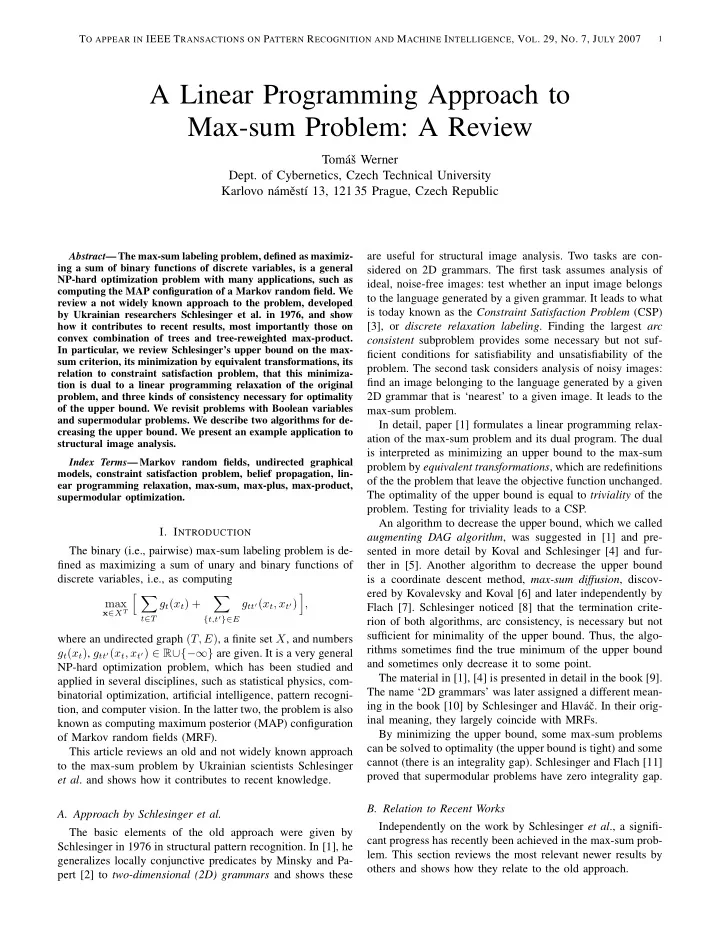

T O APPEAR IN IEEE T RANSACTIONS ON P ATTERN R ECOGNITION AND M ACHINE I NTELLIGENCE , V OL . 29, N O . 7, J ULY 2007 1 A Linear Programming Approach to Max-sum Problem: A Review Tom´ aˇ s Werner Dept. of Cybernetics, Czech Technical University Karlovo n´ amˇ est´ ı 13, 121 35 Prague, Czech Republic are useful for structural image analysis. Two tasks are con- Abstract — The max-sum labeling problem, defined as maximiz- ing a sum of binary functions of discrete variables, is a general sidered on 2D grammars. The first task assumes analysis of NP-hard optimization problem with many applications, such as ideal, noise-free images: test whether an input image belongs computing the MAP configuration of a Markov random field. We to the language generated by a given grammar. It leads to what review a not widely known approach to the problem, developed is today known as the Constraint Satisfaction Problem (CSP) by Ukrainian researchers Schlesinger et al. in 1976, and show [3], or discrete relaxation labeling . Finding the largest arc how it contributes to recent results, most importantly those on convex combination of trees and tree-reweighted max-product. consistent subproblem provides some necessary but not suf- In particular, we review Schlesinger’s upper bound on the max- ficient conditions for satisfiability and unsatisfiability of the sum criterion, its minimization by equivalent transformations, its problem. The second task considers analysis of noisy images: relation to constraint satisfaction problem, that this minimiza- find an image belonging to the language generated by a given tion is dual to a linear programming relaxation of the original problem, and three kinds of consistency necessary for optimality 2D grammar that is ‘nearest’ to a given image. It leads to the of the upper bound. We revisit problems with Boolean variables max-sum problem. and supermodular problems. We describe two algorithms for de- In detail, paper [1] formulates a linear programming relax- creasing the upper bound. We present an example application to ation of the max-sum problem and its dual program. The dual structural image analysis. is interpreted as minimizing an upper bound to the max-sum Index Terms — Markov random fields, undirected graphical problem by equivalent transformations , which are redefinitions models, constraint satisfaction problem, belief propagation, lin- of the the problem that leave the objective function unchanged. ear programming relaxation, max-sum, max-plus, max-product, The optimality of the upper bound is equal to triviality of the supermodular optimization. problem. Testing for triviality leads to a CSP. An algorithm to decrease the upper bound, which we called I. I NTRODUCTION augmenting DAG algorithm , was suggested in [1] and pre- The binary (i.e., pairwise) max-sum labeling problem is de- sented in more detail by Koval and Schlesinger [4] and fur- fined as maximizing a sum of unary and binary functions of ther in [5]. Another algorithm to decrease the upper bound discrete variables, i.e., as computing is a coordinate descent method, max-sum diffusion , discov- ered by Kovalevsky and Koval [6] and later independently by � � � � max g t ( x t ) + g tt ′ ( x t , x t ′ ) , Flach [7]. Schlesinger noticed [8] that the termination crite- x ∈ X T t ∈ T { t,t ′ }∈ E rion of both algorithms, arc consistency, is necessary but not sufficient for minimality of the upper bound. Thus, the algo- where an undirected graph ( T, E ) , a finite set X , and numbers rithms sometimes find the true minimum of the upper bound g t ( x t ) , g tt ′ ( x t , x t ′ ) ∈ R ∪{−∞} are given. It is a very general and sometimes only decrease it to some point. NP-hard optimization problem, which has been studied and The material in [1], [4] is presented in detail in the book [9]. applied in several disciplines, such as statistical physics, com- The name ‘2D grammars’ was later assigned a different mean- binatorial optimization, artificial intelligence, pattern recogni- ing in the book [10] by Schlesinger and Hlav´ aˇ c. In their orig- tion, and computer vision. In the latter two, the problem is also inal meaning, they largely coincide with MRFs. known as computing maximum posterior (MAP) configuration By minimizing the upper bound, some max-sum problems of Markov random fields (MRF). can be solved to optimality (the upper bound is tight) and some This article reviews an old and not widely known approach cannot (there is an integrality gap). Schlesinger and Flach [11] to the max-sum problem by Ukrainian scientists Schlesinger proved that supermodular problems have zero integrality gap. et al . and shows how it contributes to recent knowledge. B. Relation to Recent Works A. Approach by Schlesinger et al. Independently on the work by Schlesinger et al ., a signifi- The basic elements of the old approach were given by cant progress has recently been achieved in the max-sum prob- Schlesinger in 1976 in structural pattern recognition. In [1], he lem. This section reviews the most relevant newer results by generalizes locally conjunctive predicates by Minsky and Pa- others and shows how they relate to the old approach. pert [2] to two-dimensional (2D) grammars and shows these
Recommend
More recommend